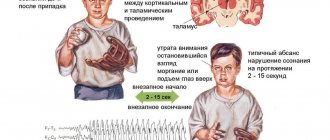Lennox-Gastaut syndrome
Symptomatic Lennox-Gastaut syndrome, as a rule, debuts against the background of an existing lag in mental and mental development. In the cryptogenic form, the development of the child at the time of manifestation of the syndrome corresponds to the norm. LGS is characterized by a large variability of attacks, their varying duration and frequency.
Atonic paroxysms
caused by short-term loss of muscle tone. With their generalized nature, the child falls, the so-called. "drop attack". Local paroxysms can take the form of sudden bending of the knees, objects falling out of hands, nodding the head, etc. A distinctive feature of atonic episodes in LGS is their lightning speed and short duration (up to 5 seconds). Generalized atonic paroxysms of LSH require differentiation from attacks of myoclonic-astatic epilepsy, fainting, and stroke.
Myoclonic paroxysms
represent local muscle twitching. Most often it affects the flexor muscles of the proximal arms; when it spreads to the lower extremities, a fall occurs. They are characterized by symmetrical serial occurrence in both limbs and stereotypy. Need differentiation from myoclonus in tick-borne encephalitis and toxic lesions of the central nervous system; non-epileptic myoclonus, which is characterized by irregular asymmetric myoclonus that occurs in response to various sensory stimuli (sound, light, touch) and is not accompanied by EEG changes.
Tonic paroxysms
DES often occur during sleep and are distinguished by their short duration (average duration 10 seconds). Accompanied by a loss of consciousness. They may be generalized in nature or manifest themselves in the form of tonic tension of individual muscle groups (posterior cervical, dorsal, abdominal muscles, shoulder girdle, etc.). Tonic paroxysms are accompanied by tachycardia, facial cyanosis, lacrimation, apnea, and hypersalivation. Minimal local paroxysms of a tonic nature can sometimes be difficult to differentiate from yawning or stretching.
Atypical absence seizures
associated with partial impairment of consciousness. They manifest themselves as temporary “numbness”, lack of any physical activity. With a short duration, absence seizures are often not recognized by people around the child. With LPH, absence seizures can be accompanied by muscle hypotonia (atonic absences) and hypertonicity of the back muscles (retropulsive absences). More often than other types of epilepsy, Lennox-Gastaut syndrome is accompanied by absence seizures—absences that continuously follow each other. This non-convulsive epistatus usually occurs upon awakening and can last several hours or days.
Psychomotor development delay
(ZPR) is noted in almost all cases of LGS. Its severity depends on the form of the syndrome (cryptogenic or symptomatic), the nature of the background pathology of the central nervous system, the severity and frequency of epileptic paroxysms. As a rule, problems with learning new skills and mastering new information come to the fore. Aggression, hyperactivity, emotional instability, and character traits characteristic of autism are often observed. About 50% of adolescents with Lennox-Gastaut syndrome do not have self-care skills. Another 25% are socially and emotionally maladjusted due to severe mental retardation. Features of behavior and character do not provide the opportunity to adapt normally in society even to those patients whose mental retardation is mild. Normal social adaptation is observed only in 15% of cases.
Reasons for development
To date, it has not been possible to find out why epileptic activity of the cryptogenic type of brain occurs. However, scientists concluded that the development of the disease can be triggered by the following factors:
- burdened heredity;
- complications after traumatic brain injury;
- history of stroke;
- a brain tumor;
- intoxication with chemicals.
The most likely cause of the pathology is considered to be a genetic predisposition.
Dietary recommendations
Since there are no effective methods to combat the syndrome, the main goal is to improve the patient’s quality of life. A properly selected diet helps reduce clinical manifestations. The diet for many types of epilepsy involves reducing the amount of carbohydrates consumed and increasing fat in the diet. At the same time, products with a high content of medium chain triglycerides have a proven effect. These compounds have a beneficial effect on nerve structures, due to which the incidence of attacks is reduced. Nutrients are found in coconut oil, which is used as a food additive.
Diagnostics
Lennox-Gastaut syndrome is defined by the presence of a clinical triad. The triad consists of multiple seizure types of different types, a characteristic EEG wave pattern (slow [1.5-2.5 Hz] saccadic wave pattern) (note that this pattern may not be present on every EEG.), some degree of cognitive and behavioral violations. However, these symptoms may not be present at the onset of the disease, making an accurate diagnosis of LGS difficult. The wide range of possible causes of Lennox-Gastaut syndrome also makes diagnosis difficult.
The diagnosis of LGS is usually made based on a thorough clinical evaluation, a detailed patient history, and a complete physical and neurological examination, including advanced imaging techniques such as electroencephalography (EEG) and magnetic resonance imaging (MRI). During an EEG, electrical impulses from the brain are recorded. In people with LGS, such EEG testing usually reveals a characteristic brain wave (slow [1.5-2.5 Hz] saccadic wave). An MRI produces three-dimensional images that depict the anatomy of the brain; These scans help doctors examine the structure of the brain and possibly determine the cause of seizure activity.
Pathogenesis of the disorder
Although the first symptoms appear in children aged two to eight years, there is a separate focus group of patients in whom the disease manifests itself at 4-6 years of age.
In some cases, the disease transforms from West syndrome, which is diagnosed in children under one year of age. Then the syndrome will develop according to one of the scenarios:
- infantile spasms of West syndrome are replaced by tonic attacks, skipping the latent form and turning into Lennox-Gastaut syndrome;
- infantile spasms of West syndrome disappear, and psychomotor development improves.
Complex of provoking factors
To date, the specific causes of this type of epilepsy are not known. Risk factors include:
- oxygen starvation of the fetus in the prenatal period;
- damage to the child’s brain during the prenatal and natal periods - premature birth, physiological underdevelopment;
- infectious brain lesions due to rubella, encephalitis, meningitis;
- cortical dysplasia - a disorder of the structure of the cerebral cortex;
- Tuberous sclerosis is a benign tumor in a variety of tissues and organs.
- idiopathic factor - the disease develops for unknown reasons;
- genetic predisposition.
Standard Treatments
No specific therapy for Lennox-Gastaut syndrome is effective in all cases, and the disorder is particularly resistant to most treatment options. The three main forms of treatment for Lennox-Gastaut syndrome are antiepileptic drugs (AEDs), dietary therapy (usually a ketogenic diet), or machine/surgery (electrical vagus nerve stimulation or corpus callosotomy). In rare cases, resection surgery is possible.
Treatment may require the coordinated efforts of a team of specialists. Pediatricians, neurologists, pediatric neurologists, surgeons, and/or other health care providers may require systematic and comprehensive treatment planning for the affected child. Families should work with health care providers to develop a treatment plan that covers a variety of potential situations, such as seizure emergencies, common medical conditions, or what to do if the affected person misses medications. Families should also keep a list of medications that may worsen the disease. A patient's treatment regimen will need to be reviewed repeatedly throughout the person's life, as the types and frequency of attacks may change and the effectiveness of a particular therapy may decrease.
Antiepileptic drugs (AEDs) are commonly given to people with Lennox-Gastaut syndrome, but individual response varies greatly. In some cases, it is possible that treatment with AEDs may help reduce or control various types of seizure activity associated with LGS. However, because people with Lennox-Gastaut syndrome have different types of seizures, they often require treatment with multiple types of AEDs. Such medications may include clonazepam, sodium valproate, topiramate, lamotrigine, felbamate (under close monitoring), clobazam, rufinamide, or cannabidiol. However, such medications may have limited success in treating seizure activity in some people with the disorder. In addition, AEDs can cause significant side effects, especially in people who take many medications at high doses. AEDs may also become less effective over time.
Valproate (valproic acid) is generally considered first-line treatment for Lennox-Gastaut syndrome because it is effective against a wide range of seizures. Valproate is usually given alone first (monotherapy), and if it is not effective, another drug such as lamotrigine, topiramate, rufinamide, clobazam or cannabidiol may be added.
Additional therapies that have been used to treat people with Lennox-Gastaut syndrome include the ketogenic diet, electrical stimulation of the vagus nerve, and various surgical techniques. These options are generally reserved for individuals who have been treated with at least 2-3 approved drugs without adequate response and are usually combined with drug therapy (the exception is dietary therapy, which is usually added to drug therapy but is rarely successful by itself).
A ketogenic diet may reduce seizure activity in some patients with LGS. The ketogenic diet is a high-fat, high-carbohydrate diet that forces the body to burn fat for energy instead of sugar (glucose). This is a strict diet that requires strict adherence and commitment. The ketogenic diet may have side effects, and people following the diet should be regularly monitored by their doctors and a qualified dietitian. The effectiveness of the ketogenic diet varies widely. Researchers don't understand why the diet is effective for some but not for others.
Some patients with Lennox-Gastaut syndrome, especially those who have not responded to other forms of therapy, can be treated with surgical techniques, including a full body callosotomy or electrical stimulation of the vagus nerve.
Corporal callosotomy is a surgical procedure in which the hemispheres of the brain are separated by cutting the corpus callosum, which is a large bundle of nerves that connects the two halves (hemispheres) of the brain and allows them to exchange information. This procedure does not involve cutting brain tissue. This procedure is usually reserved for individuals who suffer from intractable seizures that result in injury (such as frequent generalized tonic-clonic seizures). This therapy is most effective for atonic, tonic and tonic-clonic seizures.
Electrical vagus nerve stimulation is a procedure in which a device called a pulse generator is inserted into the chest and a wire is passed under the skin to the vagus nerve in the neck. The pulse generator is similar to a pacemaker and transmits weak electrical impulses to the brain through the vagus nerve. These impulses prevent the occurrence of seizures. The intensity and timing of the impulses are determined based on the needs of each person.
Disorders with similar symptoms
Symptoms of the following disorders may be similar to those of Lennox-Gastaut syndrome. Comparisons may be useful for differential diagnosis.
- West syndrome is a type of epilepsy characterized by spasms, an abnormal brain wave pattern (interectal EEG) called hypsarrhythmia, and cognitive dysfunction. The spasms that occur can range from violent movements where the entire body is doubled over, or may be nothing more than mild twitching of the shoulder or eyes. These seizures usually begin in the first months after birth and can sometimes go away with treatment. There are many different causes of West syndrome, and if a specific cause can be identified, a diagnosis of symptomatic West syndrome can be made. If the cause cannot be determined, a diagnosis of cryptogenic West syndrome is made. Some children with West syndrome may develop Lennox-Gestau syndrome.
- Epilepsy is a general term for a group of neurological disorders characterized by recurrent seizures and associated with abnormal electrical discharges in the brain. It is characterized by loss of consciousness, seizures, confusion and disturbances of the autonomic nervous system. The attacks may be preceded by an “aura,” a feeling of restlessness or sensory discomfort; the aura marks the onset of a seizure in the brain. Typically, this occurs with partial seizures. There are many different types of epilepsy and the exact cause is unknown. Epilepsy can also occur as part of larger syndromes. Types of epilepsy or epilepsy-related disorders include Rett syndrome, Angelman syndrome, Landau-Kleffner syndrome, Dravet syndrome, and neuronal ceroid lipofuscinoses.
Drug therapy
The goal of therapy is to reduce the frequency of attacks. The drugs are selected individually, taking into account the minimal occurrence of side effects.
The following anticonvulsants are prescribed:
- Clobazam;
- Rufinamide;
- Sodium divalproate;
- Lamotrigine;
- Topiramate;
- Depakine;
- Carbamazepine;
Often, the use of one product does not give the desired results. The drugs are prescribed in a comprehensive manner, and the intake is strictly controlled by the attending physician.
Causes and risk factors
Approximately 70 to 80 percent of patients with Lennox-Gastaut syndrome have an identifiable cause. These cases can be called symptomatic Lennox-Gastaut syndrome. Examples of conditions that can cause Lennox-Gastaut syndrome include:
- abnormal development of the cerebral cortex (cortical dysplasia);
- congenital infections;
- stroke;
- head injuries;
- decreased oxygen supply that occurs before birth (perinatal hypoxia);
- central nervous system infections such as encephalitis or meningitis;
- a rare genetic disease called tuberous sclerosis.
About 17 to 30 percent of people with FGS have a history of West syndrome. In general, these cases tend to be more severe.
Lennox-Gastaut syndrome may also be classified as cryptogenic, in which the cause is unknown or cannot be determined after examination. Cryptogenic cases are suspected to be the result of an unidentified condition (secondary Lennox-Gastaut syndrome). Individuals with cryptogenic LGS had no previous history of seizure activity, preexisting neurological problems, or cognitive impairment before developing the disorder. Cryptogenic cases usually have a later onset than symptomatic cases.
In some cases of Lennox-Gastaut syndrome, there is no or suspected underlying condition and the cause of the disorder is unknown.
Although the cause of LGS is known in most cases, the precise mechanisms underlying the various attacks that characterize the disorder are unknown. Researchers have not found any genes associated with Lennox-Gastaut syndrome, although the disorder may have a genetic component that contributes to its development. More research is needed to determine the specific factors, including any potential genetic factors, that are involved in the development of LGS.
Diagnosis of the disease
The diagnosis of the disease is made based on the following activities:
- Collecting anamnesis - at what age the first symptoms appeared, how the birth took place, whether there were people with epilepsy in the family, how the mental and physical development of the child proceeded.
- Neurological examination - a conversation with the child, the use of special tests and scales to identify mental retardation.
- Electroencephalography is the analysis of electrical activity in the brain. Patients exhibit diffuse slow sharp waves. The procedure is carried out throughout the whole day in a state of wakefulness and rest, which allows you to track the frequency of attacks.
- MRI and CT are a layer-by-layer examination of the brain structure in order to detect damage to its structures.
Treatment of Lennox-Gastaut disease involves the use of several methods.








